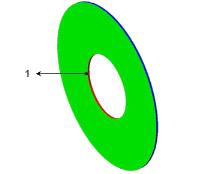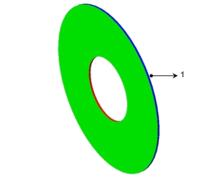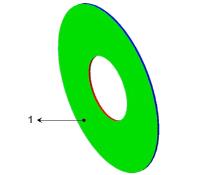Natural Convection: Exercise 1—Setting up the Model
Extracting the Fluid Domain
1. Click > and navigate to the folder with the downloaded parts. Click OK.
2. Click > .
3. From the File Open dialog box, browse to the annulus_natural_convection folder and select annulus_natural_convection.asm. Click Open.
4. Click  in the Graphics toolbar to display the style elements. Select
in the Graphics toolbar to display the style elements. Select  Shading, or
Shading, or  Shading with Edges.
Shading with Edges.
 in the Graphics toolbar to display the style elements. Select
in the Graphics toolbar to display the style elements. Select  Shading, or
Shading, or  Shading with Edges.
Shading with Edges.5. Click the Applications tab.
6. Click  Flow Analysis. The Flow Analysis tab opens.
Flow Analysis. The Flow Analysis tab opens.
 Flow Analysis. The Flow Analysis tab opens.
Flow Analysis. The Flow Analysis tab opens.7. Click  New Project. The New Project dialog box opens. Click OK to create a new project Project 1.
New Project. The New Project dialog box opens. Click OK to create a new project Project 1.
 New Project. The New Project dialog box opens. Click OK to create a new project Project 1.
New Project. The New Project dialog box opens. Click OK to create a new project Project 1.8. Click  Select Simulation Domains. The Domain Model Selection box opens.
Select Simulation Domains. The Domain Model Selection box opens.
 Select Simulation Domains. The Domain Model Selection box opens.
Select Simulation Domains. The Domain Model Selection box opens.9. In the Domain Model Selection box, select Add fluid domain.
10. In the Model Tree select CONCENTRIC_ANNULUS.PRT.
11. Middle-click to confirm. The fluid domain appears in the Domain Model Selection dialog box under Fluid Components.
12. Click OK. The fluid domain appears in the Flow Analysis Tree, as CONCENTRIC_ANNULUS under Domains.
Adding Boundary Conditions
1. Under Domains, right-click and select CONCENTRIC_ANNULUS.
2. In the graphics window, select the inner surface highlighted in red below.

3. Click OK. Under General Boundaries, a new entity BC_00001 is added.
4. Under Domains, right-click and select CONCENTRIC_ANNULUS.
5. In the graphics window, select the outer surface highlighted in blue below.

6. Click OK. Under General Boundaries, a new entity BC_00002 is added.
7. Under Domains, right-click and select CONCENTRIC_ANNULUS.
8. In the graphics window, select the top surface highlighted in green below.

9. Click OK. Under General Boundaries, a new entity BC_00003 is added.
10. Under Domains, right-click and select CONCENTRIC_ANNULUS.
11. In the graphics window, select the bottom surface.
12. Click OK. Under General Boundaries, a new entity BC_00004 is added.
13. Right-click and rename the following boundary conditions:
◦ BC_00001 as inner_surface
◦ BC_00002 as outer_surface
◦ BC_00003 as top_surface
◦ BC_00004 as bottom_surface
Parent topic
 Open
Open